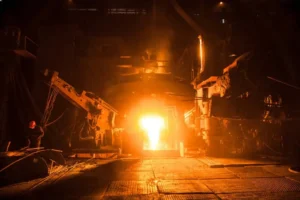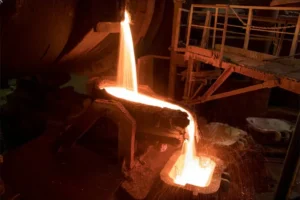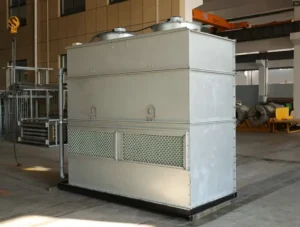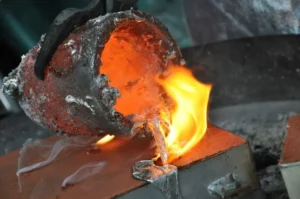Prinsip kerja tungku induksi adalah pemanasan induksi elektromagnetik. Lalu bagaimana distribusi medan elektromagnetik yang dihasilkannya? Dan apa dampaknya terhadap kesehatan manusia? Akhirnya, ada perisai elektromagnetik dan langkah-langkah perlindungan.
Pembangkitan dan Distribusi Medan Elektromagnetik pada Tungku Induksi
Prinsip kerja inti tungku induksi adalah induksi elektromagnetik. Ketika arus bolak-balik dialirkan ke kumparan induksi oleh catu daya frekuensi menengah, medan magnet bolak-balik dihasilkan di sekitar kumparan. Medan magnet ini menembus muatan logam, dan menurut hukum induksi elektromagnetik Faraday, arus eddy diinduksi dalam muatan. Arus eddy ini diubah menjadi energi panas karena hambatan muatan, sehingga mencapai pemanasan dan pencairan.
Karena itu, tungku induksi menghasilkan dua jenis medan elektromagnetik utama selama operasi:
- Medan Magnet (bidang-H): Langsung dihasilkan oleh arus yang mengalir melalui kumparan induksi, kekuatannya erat kaitannya dengan besarnya arus dan geometri kumparan (jumlah putaran, diameter, panjang, dll.). Garis-garis medan magnet adalah loop tertutup yang mengelilingi konduktor pembawa arus. Di sekitar tungku induksi, kekuatan medan magnet biasanya paling kuat di dekat kumparan induksi dan menurun dengan cepat seiring bertambahnya jarak.
- Medan Listrik (bidang-E): Meskipun mekanisme pemanasan utama pada tungku induksi adalah induksi magnetik, perubahan medan magnet juga menginduksi medan listrik (menurut persamaan Maxwell). Selain itu, catu daya frekuensi menengah itu sendiri menghasilkan medan listrik tertentu. Kuat medan listrik berhubungan dengan tegangan dan distribusi spasial potensial listrik.
Distribusi medan elektromagnetik di sekitar tungku induksi merupakan masalah spasial kompleks yang dipengaruhi oleh faktor-faktor berikut:
- Desain Kumparan Induksi: Bentuknya, ukuran, jumlah putaran, dan posisi relatif kumparan terhadap badan tungku merupakan faktor penting yang menentukan distribusi medan elektromagnetik. Misalnya, desain kumparan induksi terlindung dapat secara efektif mengurangi kebocoran medan magnet eksternal.
- Frekuensi operasi: Tungku induksi biasanya beroperasi pada rentang frekuensi ratusan Hertz hingga puluhan kilohertz. Medan elektromagnetik dengan frekuensi berbeda memiliki karakteristik propagasi dan kemampuan penetrasi yang berbeda di ruang angkasa.
- Daya Keluaran: Daya yang lebih tinggi menyebabkan arus yang lebih besar mengalir melalui kumparan, menghasilkan medan elektromagnetik yang dihasilkan lebih kuat.
- Struktur dan Bahan Badan Tungku: Badan tungku itu sendiri dan struktur logam di sekitarnya dapat memiliki efek perisai atau peningkatan pada distribusi medan elektromagnetik.
Dampak Kesehatan Medan Elektromagnetik dari Tungku Induksi pada Manusia
Dampak medan elektromagnetik terhadap kesehatan manusia adalah bidang yang kompleks dan terus diteliti. Mengenai medan elektromagnetik yang dihasilkan oleh tungku induksi, kekhawatiran utamanya adalah:
- Efek Langsung: Medan magnet bolak-balik yang kuat dapat menyebabkan arus lemah di dalam jaringan manusia, yang dapat menyebabkan rangsangan saraf dan otot. Di bawah medan magnet intensitas tinggi, ketidaknyamanan seperti pusing dan mual dapat terjadi.
- Efek Jangka Panjang: Apakah paparan jangka panjang terhadap medan elektromagnetik intensitas rendah memiliki efek kesehatan jangka panjang (seperti meningkatkan risiko kanker atau mempengaruhi sistem reproduksi) masih dalam penyelidikan ilmiah, dan belum ada kesimpulan yang pasti. Namun, untuk alasan keamanan, mengambil tindakan perlindungan yang wajar masih sangat penting.
- Efek pada Alat Kesehatan Implan: Medan elektromagnetik yang dihasilkan oleh tungku induksi dapat mengganggu pengoperasian normal perangkat medis implan tertentu (seperti alat pacu jantung dan defibrilator kardioverter implan), menimbulkan risiko keselamatan bagi pemakainya.
Tindakan Perlindungan dan Perisai Elektromagnetik yang Efektif
Untuk menjamin keselamatan operator dan lingkungan sekitar, perisai elektromagnetik yang efektif dan tindakan perlindungan perlu diterapkan:
- Optimalkan Desain Peralatan:
- Gunakan Kumparan Induksi Terlindung: Dengan menempatkan lapisan pelindung konduktif (biasanya terbuat dari bahan yang sangat konduktif seperti tembaga atau aluminium) di luar koil induksi dan menghubungkannya ke ground dengan benar, kebocoran medan magnet dapat ditekan secara efektif.
- Penataan Komponen Listrik yang Wajar: Posisikan komponen yang menghasilkan medan elektromagnetik yang kuat (seperti catu daya frekuensi menengah dan transformator) sejauh mungkin dari area pengoperasian dan masukkan ke dalam wadah logam sebagai pelindung.
- Optimalkan Struktur Tubuh Tungku: Memanfaatkan struktur logam badan tungku itu sendiri untuk tingkat perlindungan elektromagnetik, seperti mengadopsi desain bodi tungku tertutup.
- Tetapkan Zona Perlindungan Keselamatan dan Rambu Peringatan:
- Batasi Zona Bahaya Radiasi Elektromagnetik: Berdasarkan kekuatan medan elektromagnetik yang diukur, membatasi zona perlindungan pada tingkat yang berbeda dan memasang tanda peringatan yang jelas untuk mengingatkan personel agar memperhatikan keselamatan.
- Batasi Akses Personil: Batasi akses ke area dengan medan elektromagnetik tinggi bagi personel yang tidak berkepentingan dengan memasang penghalang fisik (seperti pagar dan pintu pengaman) atau menetapkan prosedur operasi.
- Menerapkan Tindakan Perlindungan Pribadi:
- Kenakan Pakaian Pelindung Elektromagnetik: Bila perlu memasuki area medan elektromagnetik tinggi untuk pengoperasian atau pemeliharaan, operator harus mengenakan pakaian pelindung dengan kemampuan pelindung elektromagnetik.
- Gunakan Alat Ukur Medan Elektromagnetik: Pantau kekuatan medan elektromagnetik di tempat kerja secara teratur untuk memastikannya berada dalam standar aman.
- Pelatihan dan Informasi: Memberikan pelatihan kepada operator tentang pengetahuan keselamatan medan elektromagnetik, memberi tahu mereka tentang potensi risiko dan tindakan perlindungan.
- Mengembangkan Prosedur Operasional yang Aman:
- Standarisasi Prosedur Operasi: Kembangkan prosedur pengoperasian terperinci yang secara jelas mendefinisikan langkah-langkah pengoperasian dan tindakan pencegahan keselamatan untuk mengurangi waktu paparan personel di lingkungan dengan medan elektromagnetik tinggi.
- Perawatan dan Inspeksi Reguler: Periksa dan rawat secara teratur perangkat pelindung elektromagnetik tungku induksi untuk memastikan efektivitasnya.
- Pertimbangkan Perlindungan Individu dengan Alat Kesehatan Implan:
- Identifikasi dan Pemberitahuan yang Jelas: Tempatkan tanda yang jelas di area kerja tungku induksi untuk mengingatkan individu dengan perangkat medis implan agar menjauh.
- Mengembangkan Prosedur Operasi Khusus: Untuk individu dengan perangkat implan yang perlu bekerja di dekat tungku induksi, melakukan penilaian risiko dan mengembangkan prosedur operasi khusus yang aman.
Metode Analisis Medan Elektromagnetik
Menganalisis medan elektromagnetik di sekitar tungku induksi adalah dasar untuk mengembangkan tindakan perlindungan yang efektif. Metode analisis umum meliputi:
- Perhitungan Teoritis: Berdasarkan teori medan elektromagnetik (seperti hukum Biot-Savart dan persamaan Maxwell), pemodelan matematika digunakan untuk menghitung distribusi medan elektromagnetik. Metode ini dapat memprediksi dampak parameter desain yang berbeda terhadap medan elektromagnetik.
- Simulasi Numerik: Menggunakan software simulasi numerik seperti Finite Element Analysis (FEA), model tiga dimensi medan elektromagnetik tungku induksi dibuat dan dianalisis. Metode ini dapat mensimulasikan efek geometri kompleks dan sifat material pada medan elektromagnetik dengan lebih akurat.
- Pengukuran di Tempat: Alat ukur medan elektromagnetik profesional (seperti pengukur kuat medan magnet dan pengukur kuat medan listrik) digunakan untuk mengukur kekuatan medan elektromagnetik di sekitar tungku induksi untuk mendapatkan data nyata.
Dengan menerapkan perhitungan teoritis secara komprehensif, simulasi numerik, dan pengukuran di tempat, pemahaman menyeluruh tentang karakteristik distribusi medan elektromagnetik tungku induksi dapat dicapai, memberikan dasar untuk mengembangkan langkah-langkah perlindungan keselamatan yang ilmiah dan masuk akal.







